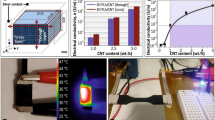Abstract
Our research is focused on the engineering of novel, highly sensitive and miniaturized hybrid materials from carbon nanotubes (CNTs) and DNA molecules for applications in biosensors and medical devices. These hybrid sensors allow for a high degree of miniaturization, a key factor in the design of lightweight components while maintaining the advantages of in-situ and real-time analysis capabilities. In the first phase of the sensor design process, we investigated the structural and electrical properties of the supramolecular complexes made of amide-functionalized CNTs and double-stranded DNA. The solubilization properties of the hybrid nanotubes in aqueous solutions with different concentrations of DNA were studied, and an optimal ratio of nanotubes and biomolecules to achieve a good level of dispersion was found. Complexes formed in aqueous solution from CNTs and DNA are highly stable and maintain their properties up to one month from preparation. The morphology of the CNT-DNA composites was investigated at the nanoscale level using atomic force microscopy (AFM) and electron microscopy (SEM). Results from these experiments show the strong affinity between the surface of the amide-functionalized CNTs and the DNA strands. Further, the CNT-DNA films were investigated by atomic force microscopy in the PeakForce TUNA mode to assess the suitability of this technique in determining the local conductive properties of the hybrid films.
Similar content being viewed by others
References
G. Sanchez-Pomales, L. Santiago-Rodriguez, and C. R. Cabrera, J. Nanosci. Nanotechnol. 9, 2175 (2009).
C. Staii, A. T. Johnson, M. Chen, and A. Gelperin, Nano Lett. 5, 1774 (2005).
M. Zheng, A. Jagota, E. D. Semke, B. A. Diner, R. S. McLean, S. R. Lustig, R. E. Richardson, and N. G. Tassi, Nat. Mater. 2, 338 (2003).
X. Tu and M. Zheng, Nano Res. 1, 185 (2008).
M. G. Santonicola, S. Laurenzi, and M. Marchetti, Proceedings of the 61st International Astronautical Conference 2010, 13, 10938–10940 (2010).
G. M. Santonicola and E. W. Kaler, Langmuir 21, 9955 (2005).
P. Schön, K. Bagdi, K. Molnar, P. Markus, B. Pukanszky, and G. J. Vancso, Eur. Polym. J. 47, 692 (2011).
S. Desbief, N. Hergue, O. Douheret, M. Surin, P. Dubois, Y. Geerts, R. Lazzaroni, and P. Leclere, Nanoscale 4, 2705 (2012).
Acknowledgments
We thank Ramón Bueno Morles (Sapienza University of Rome) for the acquisition of SEM images. This work was financially supported by the Italian Ministry of Education, University and Research (MIUR) through the Montalcini Grant to M.G.S.
Author information
Authors and Affiliations
Corresponding author
Rights and permissions
About this article
Cite this article
Santonicola, M.G., Laurenzi, S. & Schön, P.M. Self-assembled Carbon Nanotube-DNA Hybrids at the Nanoscale: Morphological and Conductive Properties Probed by Atomic Force Microscopy. MRS Online Proceedings Library 1700, 47–52 (2014). https://doi.org/10.1557/opl.2014.552
Published:
Issue Date:
DOI: https://doi.org/10.1557/opl.2014.552




